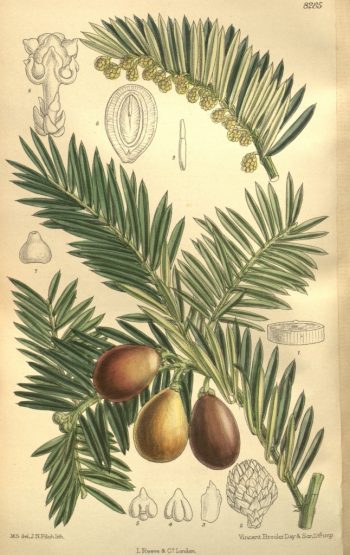
Cephalotaxus, as described in 1842 by Siebold and Zuccarini ex Stephan Friedrich Ladislaus Endlicher (1804-1849), in Genera Plantarum (Endlicher), 2nd edition, is a genus of conifers comprising 11 species, commonly collectively called plum-yews or cowtail-pines; as well as 三Š°–扊±ž (san jian shan shu) in the Chinese language. This genus name is derived from the Greek kephale, meaning "head", and taxus, referring to the head-like shape of the staminate flowers in yews.
For most of the 20th century this genus was generally treated as the sole genus in the family Cephalotaxaceae Neger (1907), although some botanical authors also placed Amentotaxus (Taxaceae) in the family. Later, detailed embryological studies by Singh (1961) showed that Cephalotaxus development differs strongly from all genera in the Taxaceae save Amentotaxus, which exhibits some intermediate characters. However, a detailed molecular analysis by Hao et al. in 2008 using both chloroplast and nuclear DNA markers to analyze all generally recognized species in the two groups, showed that the clade of Cephalotaxus with other Taxaceae genera is monophyletic. The analysis also showed that the clade C. harringtonii - C. koreana - C. wilsoniana is monophyletic, and that the latter two species could be treated as varieties of the former.
Ethnobotany. Many species are locally used for timber or firewood, and some (e.g., C. koreana) have been commercially exploited for timber. It has been used medicinally by native peoples, for instance by extraction of a seed oil in India. However, it has also been found to contain, like certain members of Taxus, anticancer alkaloids with names like cephalotaxine and harringtonine. This has led to exploitation for the purposes of extracting the anticancer compounds. Such exploitation threatens the survival of several species, but there is reason to hope that this can be avoided (as it was with Taxus) by synthesizing the compounds
Description. Plum-yews are evergreen, coniferous shrubs and small trees that reach mature heights of 3 to 30 feet (1 - 10 m) tall, rarely to 65 feet (20 m). The species are overwhelmingly dioecious with male and female fruiting bodies appearing on different plants. When monoecious, the male and female cones are often on different branches.
Distribution. This genus is native to Korea, China, Japan, Burma, Laos, Vietnam and India. Its center of distribution is in China, which holds portions of the native range of seven species. All species are highly shade tolerant, typically growing as under-story trees or shrubs in humid temperate to subtropical broadleaf forests, and are typically uncommon within their ranges. A few species can tolerate cold temperate climates (USDA Zone 5 or 6), but none can tolerate aridity, and most can be damaged by exposure to full sun. They seem to be highly browse-resistant due to unpalatability. There is some concern that they suffer from poor regeneration due to a slow reproductive cycle (about two growing seasons for both male and female full development), dioecious habit, slow growth, long distances between individual plants, and seed predation by birds and mammals (although such predation is probably the main agent of seed dispersal). All species are threatened or endangered in their native range, primarily due to habitat loss.
The species with the widest native ranges and greatest cold tolerance, C. fortunei, C. harringtonii, C. koreana and C. sinensis, can be readily found in botanical gardens and arboreta throughout the cold-temperate West. However, other species (C. griffithii, C. mannii) are rarely if ever represented in any U.S. or U.K. gardens and must be seen in their rapidly-vanishing native habitats.
The fossil record includes Jurassic specimens in Greenland, and Europe and NW North America during the Miocene and Pliocene.